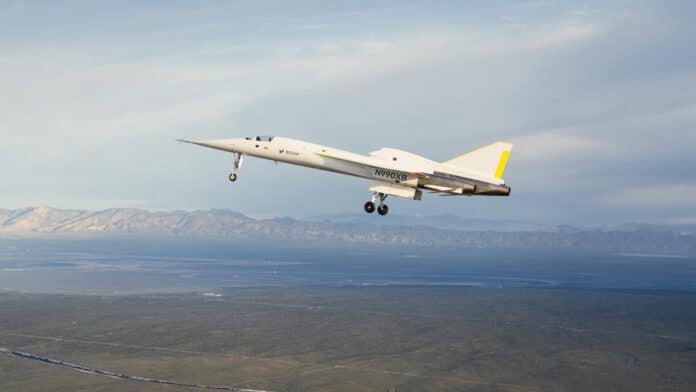XB-1 has secured the first-ever Special Flight Authorization (SFA) to Exceed Mach 1 from the Federal Aviation Administration (FAA). XB-1 test flights will continue to be conducted in the R-2508 Complex, and supersonic operations will occur in the Black Mountain Supersonic Corridor and in a portion of the High Altitude Supersonic Corridor within the R-2515 airspace, which has been used extensively for research and military supersonic aeronautical operations.
XB-1’s SFA follows a thorough review and Environmental Assessment and extends to specified chase plane aircraft, which will trail XB-1 to observe, monitor, and record the safety of the flight.
Boom’s XB-1 has already completed a successful test flight with its wheels down. However, in order to push the aircraft beyond the speed of sound, there are certain legal requirements that need to be met. Since civilian supersonic flight is not allowed in US airspace, Boom needs to obtain special permission from the FAA to carry out its supersonic flight program.
As part of this permission, the Black Mountain Supersonic Corridor at Edwards Air Force Base, California, and part of the High Altitude Supersonic Corridor within the R-2515 airspace have been designated as permissible areas for Boom to conduct supersonic test flights.
According to Boom, up to 20 subsonic tests need to be completed before moving on to Mach numbers. These tests include the first wheels-up flight, flight systems tests, subsystems tests, vibration tests, and demonstrations that the airframe can operate within safe vibration limits. The first three supersonic flights will be at Mach 1.1, 1.2, and 1.3, which will require a significant amount of airspace to conduct.
There is a new agreement in place that will allow Boom to test the XB-1 at speeds above Mach 1 while waiving some environmental regulations involving sonic booms and their effects. Additionally, a chase plane will accompany the XB-1 during the flights to aid in gathering information about performance, including handling, altitude, airspeed, and airworthiness.
“Following XB-1’s successful first flight, I’m looking forward to its historic first supersonic flight,” said Blake Scholl, founder and CEO of Boom Supersonic. “We thank the Federal Aviation Administration for supporting innovation and enabling XB-1 to continue its important role of informing the future of supersonic travel.”
Now that the XB-1 has completed its first flight and has been authorized to fly supersonic, the team will work to systematically expand the flight envelope to confirm the aircraft’s performance and handling qualities through and beyond Mach 1. This will include in-flight checks of all systems, as well as multiple test points demonstrating safe margin to flutter (vibration) boundaries. There are a total of 10-20 flights planned before reaching supersonic speeds, which will give the team ample time to thoroughly test and ensure the XB-1’s safety and reliability.
